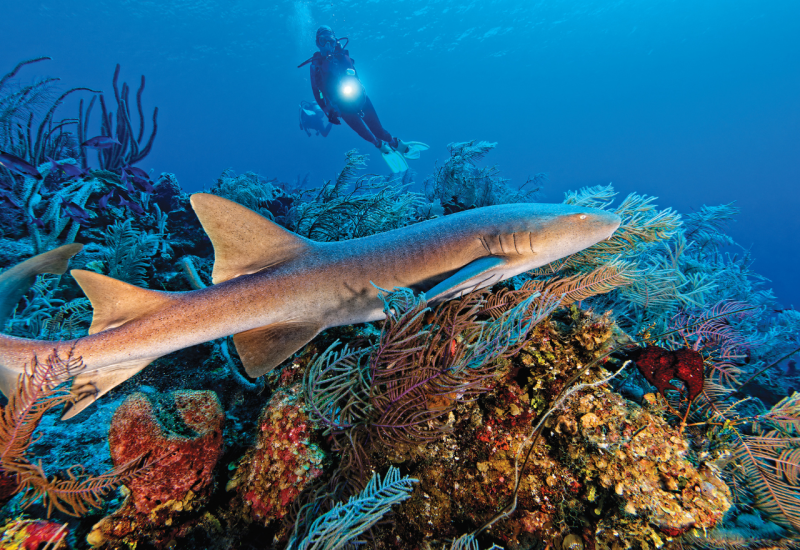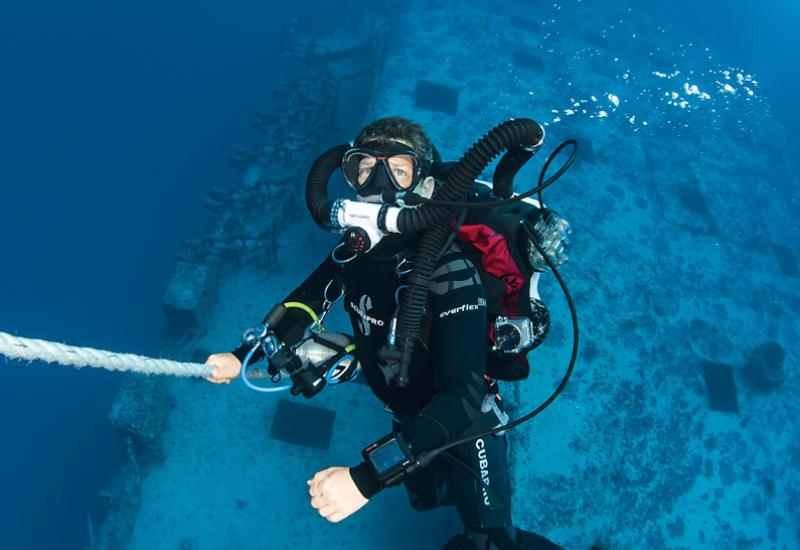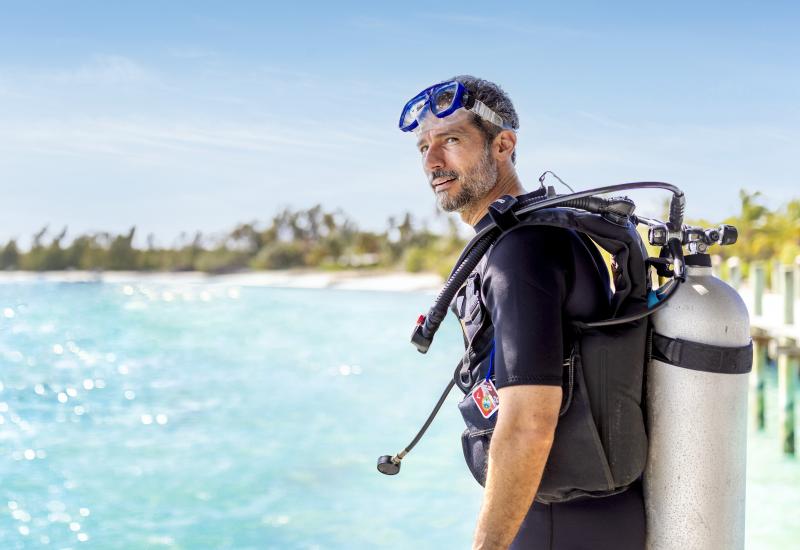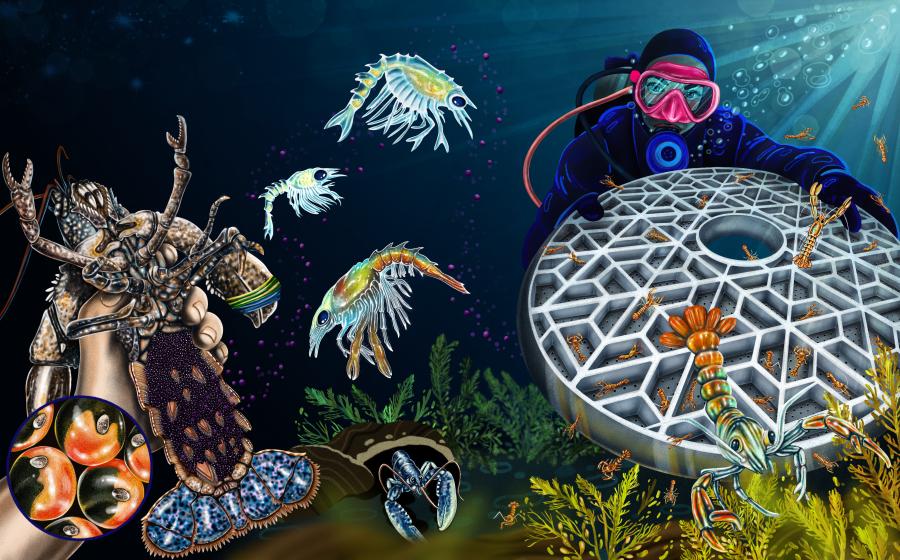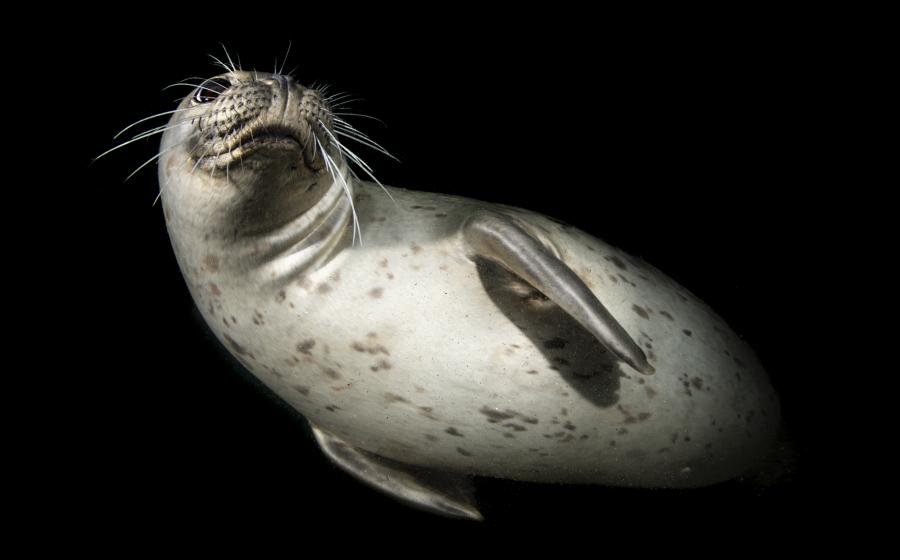How To Achieve Perfect Buoyancy On Every Dive
Want to reduce your air consumption? Be able to fin faster and farther with less effort? Look relaxed and in perfect control? Finish the dive with less fatigue? Receive approving smiles from divemasters?
The secret is pinpoint buoyancy control, and it all begins with fine-tuning your weighting—that's how much lead you thread on your belt or put into your pouches. If you are carrying just the right amount of weight, you will have the smallest amount of BC inflation. That means less drag and more efficient finning. Less BC inflation also means less buoyancy shift with depth, so you'll make fewer adjustments.

Shutterstock.comPerfect Buoyancy
How Much Weight Do I Need?
Correct weighting depends on your personal buoyancy needs and is influenced by a number of factors—from the composition of your body to the thickness of your wetsuit. You can get a rough estimate of how much weight you'll need by using our exclusive buoyancy calculator. You should be able to estimate the proper weight within 4 to 5 pounds. Now, go diving and:
Make a Surface Check
A relaxed diver with a full tank and an empty BC should sink gently while breathing through the regulator. That's right, you should be slightly negative even on a normal inhale. That's a little heavier than you might have been taught.
The rule you often hear—that you should float at eye level—is about right for the end of your dive, when you will weigh 5 pounds less. (Most of that loss is the weight of the breathing gas you will use up.) So you need about 5 pounds of extra lead at the beginning of the dive.
Make Your Safety Stop Count
The goal is to be neutral while doing your end-of-dive safety stop, so that's when you can really fine-tune your buoyancy.
With 500 psi at 15 feet, vent all the air from your BC. Concentrate on relaxing—any sculling with hands or feet will propel you upward. You should rise slowly as you inhale, sink slowly as you exhale. For your next dives, add or subtract a pound or two until you do.
If you are neutral at 15 feet at the end of your dive, you will probably be slightly positive at the surface. How positive will depend on how much neoprene you wear.
Log It
After each dive, write down what exposure suit you wore, what equipment you used, how much lead you carried, how much your body weighs and whether you seemed too heavy or light at your safety stop.
Keep it up until you get your weighting correct. Then, even if it's six months later and you've gained a few pounds, you should be able to estimate almost exactly how much lead you'll need.
Make One Final Check
Got your weighting exactly right on the first day of your vacation? Great. Now check it again a few days later. Chances are you can drop a couple more pounds. Why? You're more relaxed now, so you're breathing with less air in your lungs.
Is "Perfect" Weighting Always Perfect?
Because excellent buoyancy control and minimum weighting are the hallmarks of an expert diver, many of us feel pressure to eliminate every pound of lead we can. But sometimes that's a bad idea.
When you're wearing little or no neoprene, there's little or no buoyancy change with depth. You can therefore minimize your weighting without risking too much positive buoyancy when you ascend.
But wearing more neoprene means more changes in buoyancy as it compresses. At depth, you'll probably have to inflate your BC to compensate for it so you lose a good deal of the streamlining benefit. As you ascend, you'll have to vent that air accurately to avoid positive buoyancy. Here, a couple of extra pounds of lead will give you a margin for error.
Other reasons to be two pounds or so heavy: inexperience judging your depth and controlling your buoyancy, darkness or low visibility that reduce visual cues of an ascent, task loading, and heavy surge that can pop you to the surface from your safety stop.
Think of minimum weighting as you would the edge of a cliff. You don't want to fall over into positive buoyancy and an uncontrollable ascent. When in doubt, it's safer to stay a few steps—or pounds—back from the edge.
Fine Tune Your Trim
Finding perfect buoyancy isn't just about finding the right amount of weight, it's also about the distribution of that weight. Proper trim—the distribution of your weight front-to-back, side-to-side and head-to-toe—helps you keep your fins off the reef and maintain an efficient horizontal swimming position. You should be able to hover in a horizontal position (or, ideally, in any position) without your feet sinking or rising, without rolling to one side or the other.
If your weighting is spot-on so that you're neutral during your 15-foot safety stop, try these exercises to see if you're properly trimmed. If not, you can shift some weight to compensate. Don't expect perfection, but you can get close. (You've got at least three minutes to kill anyway.) The trick is to be as relaxed as possible. Don't fidget.

Scuba Diving Editors
The Buddha Hover—Assume the modified lotus position (feet under your thighs) and grab your fin tips. This is a good position from which to fine-tune your buoyancy because your hands keep your fins from wiggling. It also detects trim problems: Do you fall over to one side or the other?

Scuba Diving Editors
Prone Hover—Stretch out face-down and concentrate on relaxing and not moving your hands and feet. Do you roll to one side or the other? Do your fins rise or sink?

Scuba Diving Editors
Side Hover—This is a better way to detect front-to-back imbalance. Stretch out on your side and, again, concentrate on not moving your hands and feet. Do you roll?
Freshwater/Saltwater Conversion
By how much do you have to change your weight belt when going from fresh to salt water? To be accurate, you have to consider the whole package: diver plus equipment.
Stand on the bathroom scale with the equipment and weight that makes you neutral in one medium or the other. Or you can estimate. A standard aluminum 80 tank weighs 32 pounds, a 7mm wetsuit is about 8 pounds. For regulator, mask, fins, etc., figure about 15 pounds. Include your weights.
Going from fresh water to salt? Multiply by 0.025 and add that amount.
Going from salt water to fresh water? Multiply the total by 0.025 and subtract that amount from your weight belt or integrated-weight BC.
Example: You weigh 175 pounds and your equipment adjusted for salt water weighs 75 pounds, for a total of 250 pounds. 250 x 0.025 = 6.25. Subtract 6 pounds from your weight belt for fresh water.
Quick Buoyancy Tips
Take A Course—Some certifying agencies offer courses in buoyancy and weighting. Sometimes called "Peak Performance Buoyancy," the courses teach precise buoyancy control, streamlining, weight and trim adjustment, equipment configuration options and relaxation techniques. Typically, it's a two-dive, one- or two-day course.
Slow Down—"One problem many divers have in controlling their buoyancy is learning to relax in the water," says Course Director Debbie Logan. "Sometimes divers think they are relaxed, but when you see them, they are trying to move too fast and making jerky movements. That not only wastes air and wastes energy, it also makes your buoyancy harder to control."
Buoyancy Problems Q & A
Q: I did all the checks and vented my BC thoroughly, but I still have problems getting and staying down. What am I doing wrong?
Is your BC really empty? Maybe not. Almost every BC traps some air despite your best efforts to dump it. Next time you dive, feel behind your head. If the top of your BC has formed a "pillow," it has trapped some air. It may amount to several pounds of buoyancy.
Solution: To deflate that pillow, lean back as though you were relaxing in your La-Z-Boy recliner and hold your oral inflate/deflate device toward the surface. Most BCs will then vent that last bit of air.
Q: I seem to have buoyancy problems on deeper dives. I keep adding air to stay neutral at depth, then have to fight to control my ascent. Am I overlooking something?
Most divers know that neoprene compresses with depth, losing buoyancy the deeper you go. But you might be surprised by how much it compresses. Most lose half their buoyancy in the first 33 feet, two-thirds by 66 feet and nearly all of it by 100 feet. At that point, 7mm neoprene foam has become solid neoprene less than 2mm thick. In this case, the buoyancy shift between the surface and 100 feet can be more than 20 pounds from the wetsuit alone. Because you regain that much buoyancy as you ascend, you risk losing control of your ascent rate.
Solution: Begin venting air from your BC as soon as you begin ascending. Stop occasionally to make sure you are neutral or only very slightly positive. Stay ahead of the problem, because once positive buoyancy begins accelerating your ascent, it can be very hard to slow it down.
Don't initiate an ascent by adding air to your BC. That air will immediately have to be dumped. Instead, inhale normally (a normal full breath will create 2 to 4 pounds of positive buoyancy) and kick up to begin your ascent.
Finally, don't over-correct. A common mistake is to add too much air to your BC when you're a little negative, or to dump too much when you're a little positive. You can "yo-yo" around the point of neutral buoyancy all day and never seem to find it. Add or dump just a short burst of air and wait about 5 seconds for a reaction before doing it again. It can take that long, or longer, for your body's upward or downward momentum to stop and reverse.
Q: My buoyancy used to be perfect, but not anymore. I weigh as much as I used to and still wear the same wetsuit and amount of weight as before. What's changed?
Most likely it's your wetsuit. Over time, neoprene loses buoyancy because some of the cells collapse or fill with water. Frequent use—or abuse by storing your weight belt on top of it—will accelerate the process, but all wetsuits become less buoyant as they are used.
Q: I enjoy perfect buoyancy at depth and on my safety stops, so why do I always have trouble getting down those first few feet from the surface, especially on the first dive?
It's a common problem on the first dive of a vacation. It's likely that you're a little excited, which does two things. First, you probably move your hands and feet a little, which pushes you upward. Try tucking your fins under your butt, or crossing your ankles. Second, you're probably breathing with the "top half" of your lungs—from mostly filled lungs.
Solution: Try exhaling fully, then taking only a half-breath.
Finally, lots of tiny air bubbles can get trapped in the fibers of the nylon covering the outside of your wetsuit, and even more air is trapped inside the suit. All of it can add up to a couple pounds of buoyancy, but you'll lose it in the first minute or so as pressure drives out the air.
Solution: You could "burp" the suit by opening the collar seal with your finger, though you'd probably let in unnecessary cold water.
Q: Help! I took off too much weight and now I'm too positive to hover at 15 feet.
So make your safety stop at 20 feet, or 25, or even 30 if you have to. If you're wearing any neoprene, it will compress and reduce your buoyancy.
There's nothing magic about the 15-foot number. The research that led to the safety stop recommendation was actually done at various depths between 30 and 10 feet. Certainly a safety stop at 30 feet is better than no stop at all. Just try to stay at a consistent depth and when you do ascend from the stop, do so in a slow, controlled manner.
Q: I weigh 172 pounds. How much lead do I need?
Can't say. You'll have to experiment to find out. There are rules of thumb, like "10 percent of your body weight plus five pounds if you wear a 7mm wetsuit" and "five percent of your body weight if you wear a 3mm wetsuit," but they are ballpark generalizations, and big ballparks at that.
Every 172-pound diver will have a different fat/muscle/bone composition, and therefore different buoyancy. That's because fat is buoyant, but muscle, and especially bone, sink. A lean, "big boned" diver of 172 pounds might be more than 10 pounds "heavier" than a fat 172-pounder.
Specific gravity is weight in grams divided by volume in cubic centimeters. If a substance has a specific gravity higher than 1.03, it will sink in salt water.


